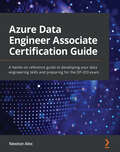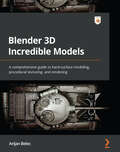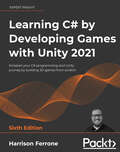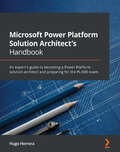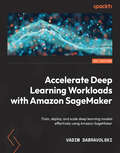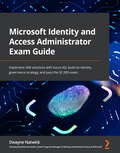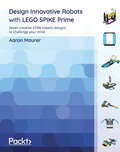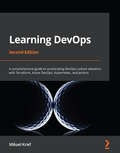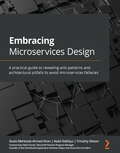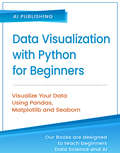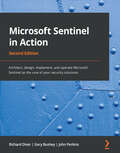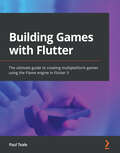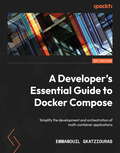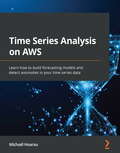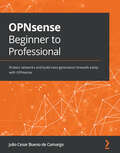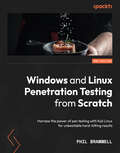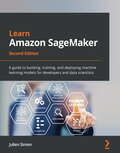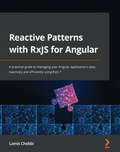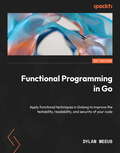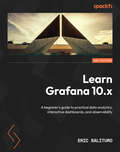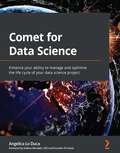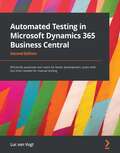- Table View
- List View
Cloud Native Automation with Google Cloud Build: Easily automate tasks in a fully managed, scalable, and secure platform
by Anthony Bushong Kent HuaWritten by two Google Cloud experts, this book will help you to create a concrete foundation of Cloud Build so that you can define workflows and pipelines as builds in Google Cloud BuildKey FeaturesLearn Cloud Build's API and build configuration/schemaApply scalability and security best practices for using Cloud BuildIntegrate Cloud Build with external systems critical to workflowsBook DescriptionWhen adopting cloud infrastructure, you are often looking to modernize the automation of workflows such as continuous integration and software delivery. Minimizing operational overhead via fully managed solutions such as Cloud Build can be tough. Moreover, learning Cloud Build's API and build schema, scalability, security, and integrating Cloud Build with other external systems can be challenging. This book helps you to overcome these challenges by cementing a Google Cloud Build foundation.The book starts with an introduction to Google Cloud Build and explains how it brings value via automation. You will then configure the architecture and environment in which builds run while learning how to execute these builds. Next, you will focus on writing and configuring fully featured builds and executing them securely. You will also review Cloud Build's functionality with practical applications and set up a secure delivery pipeline for GKE. Moving ahead, you will learn how to manage safe roll outs of cloud infrastructure with Terraform. Later, you will build a workflow from local source to production in Cloud Run. Finally, you will integrate Cloud Build with external systems while leveraging Cloud Deploy to manage roll outs.By the end of this book, you'll be able to automate workflows securely by leveraging the principles of Google Cloud Build.What you will learnGet started with Cloud Build the right wayDefine new workflows using the Cloud Build schemaImplement a secure build and deployment environment for GKEAutomate serverless workflows for Cloud Run and Cloud FunctionsIntegrate Cloud Build with source code management and artifact storesDevelop a Cloud Build strategy for your organizationWho this book is forThis book is for cloud engineers and DevOps engineers who manage cloud environments and desire to automate workflows in a fully managed, scalable, and secure platform. You are expected to have an understanding of cloud fundamentals, software delivery, and containerization fundamentals to get the most out of this book.
Azure Data Engineer Associate Certification Guide: A hands-on reference guide to developing your data engineering skills and preparing for the DP-203 exam
by Newton AlexBecome well-versed with data engineering concepts and exam objectives to achieve Azure Data Engineer Associate certificationKey FeaturesUnderstand and apply data engineering concepts to real-world problems and prepare for the DP-203 certification examExplore the various Azure services for building end-to-end data solutionsGain a solid understanding of building secure and sustainable data solutions using Azure servicesBook DescriptionAzure is one of the leading cloud providers in the world, providing numerous services for data hosting and data processing. Most of the companies today are either cloud-native or are migrating to the cloud much faster than ever. This has led to an explosion of data engineering jobs, with aspiring and experienced data engineers trying to outshine each other.Gaining the DP-203: Azure Data Engineer Associate certification is a sure-fire way of showing future employers that you have what it takes to become an Azure Data Engineer. This book will help you prepare for the DP-203 examination in a structured way, covering all the topics specified in the syllabus with detailed explanations and exam tips. The book starts by covering the fundamentals of Azure, and then takes the example of a hypothetical company and walks you through the various stages of building data engineering solutions. Throughout the chapters, you'll learn about the various Azure components involved in building the data systems and will explore them using a wide range of real-world use cases. Finally, you'll work on sample questions and answers to familiarize yourself with the pattern of the exam.By the end of this Azure book, you'll have gained the confidence you need to pass the DP-203 exam with ease and land your dream job in data engineering.What you will learnGain intermediate-level knowledge of Azure the data infrastructureDesign and implement data lake solutions with batch and stream pipelinesIdentify the partition strategies available in Azure storage technologiesImplement different table geometries in Azure Synapse AnalyticsUse the transformations available in T-SQL, Spark, and Azure Data FactoryUse Azure Databricks or Synapse Spark to process data using NotebooksDesign security using RBAC, ACL, encryption, data masking, and moreMonitor and optimize data pipelines with debugging tipsWho this book is forThis book is for data engineers who want to take the DP-203: Azure Data Engineer Associate exam and are looking to gain in-depth knowledge of the Azure cloud stack.The book will also help engineers and product managers who are new to Azure or interviewing with companies working on Azure technologies, to get hands-on experience of Azure data technologies. A basic understanding of cloud technologies, extract, transform, and load (ETL), and databases will help you get the most out of this book.
Blender 3D Incredible Models: A comprehensive guide to hard-surface modeling, procedural texturing, and rendering
by Arijan BelecLearn all about hard-surface modeling in Blender while creating three increasingly complex projects: an assault rifle, a sci-fi racing ship, and an army tankKey FeaturesExplore Blender's wide array of 3D modeling tools and features with key images printed in colorLearn techniques for texturing, rendering, and riggingEmploy these lessons to create increasingly complex hard-surface modelsBook DescriptionBlender is a massively popular and powerful 3D program, with versatile modeling abilities that make it a great way to enter the 3D modelling world. Blender 3D Incredible Models is an extensive guide for those new to hard-surface modeling with Blender, helping you understand the complete range of tools and features it offers and how to employ those efficiently to create realistic models. You'll be led through progressively more challenging modeling projects— from an assault rifle and an army tank to a sci-fi spaceship model—giving you a glimpse of all the skills you'd need in Blender's vast ecosystem of features and functionality, ranging from textures, rendering, and UV mapping to lighting, rigging, and beyond. Each engaging project builds upon the last until you're equipped with everything you need to tackle your own modeling challenges, whatever they may be. By the end of this Blender book, you won't just know how to create the models covered here, but you'll be able to turn your own concepts and references into 3D Blender models too!What you will learnDive into the fundamental theory behind hard-surface modelingExplore Blender's extensive modeling tools and featuresUse references to produce sophisticated and accurate modelsCreate models with realistic textures and materialsSet up lighting and render your scenes with styleMaster the use of polygons to make game-optimized modelsDevelop impressive animations by exploring the world of riggingEmploy texture painting and modifiers to render the tiniest detailsWho this book is forThis book is for aspiring 3D artists, animators, architectural visualizers, and game developers looking to learn hard-surface modeling, an essential skill in creative industries. A basic understanding of Blender and its interface, orienting ins the 3D Viewport, creating and moving objects, and mesh editing is necessary to get started.
Blender 3D Incredible Models: A comprehensive guide to hard-surface modeling, procedural texturing, and rendering
by Arijan BelecLearn all about hard-surface modeling in Blender while creating three increasingly complex projects: an assault rifle, a sci-fi racing ship, and an army tankKey FeaturesExplore Blender’s wide array of 3D modeling tools and features with key images printed in colorLearn techniques for texturing, rendering, and riggingEmploy these lessons to create increasingly complex hard-surface modelsBook DescriptionBlender is a massively popular and powerful 3D program, with versatile modeling abilities that make it a great way to enter the 3D modelling world. Blender 3D Incredible Models is an extensive guide for those new to hard-surface modeling with Blender, helping you understand the complete range of tools and features it offers and how to employ those efficiently to create realistic models. You’ll be led through progressively more challenging modeling projects— from an assault rifle and an army tank to a sci-fi spaceship model—giving you a glimpse of all the skills you’d need in Blender’s vast ecosystem of features and functionality, ranging from textures, rendering, and UV mapping to lighting, rigging, and beyond. Each engaging project builds upon the last until you’re equipped with everything you need to tackle your own modeling challenges, whatever they may be. By the end of this Blender book, you won’t just know how to create the models covered here, but you’ll be able to turn your own concepts and references into 3D Blender models too!What you will learnDive into the fundamental theory behind hard-surface modelingExplore Blender's extensive modeling tools and featuresUse references to produce sophisticated and accurate modelsCreate models with realistic textures and materialsSet up lighting and render your scenes with styleMaster the use of polygons to make game-optimized modelsDevelop impressive animations by exploring the world of riggingEmploy texture painting and modifiers to render the tiniest detailsWho this book is forThis book is for aspiring 3D artists, animators, architectural visualizers, and game developers looking to learn hard-surface modeling, an essential skill in creative industries. A basic understanding of Blender and its interface, orienting in the 3D Viewport, creating and moving objects, and mesh editing is necessary to get started.
Learning C# by Developing Games with Unity 2021: Kickstart your C# programming and Unity journey by building 3D games from scratch, 6th Edition
by Harrison FerroneLearn C# programming from scratch using Unity as a fun and accessible entry point with this updated edition of the bestselling series. Includes invitation to join the online Unity Game Development community to read the book alongside peers, Unity developers/C# programmers and Harrison Ferrone.Purchase of the print or Kindle book includes a free eBook in the PDF format.Key FeaturesLearn C# programming basics, terminology, and coding best practicesBecome confident with Unity fundamentals and features in line with Unity 2021Apply your C# knowledge in practice and build a working first-person shooter game prototype in UnityBook DescriptionThe Learning C# by Developing Games with Unity series has established itself as a popular choice for getting up to speed with C#, a powerful and versatile programming language with a wide array of applications in various domains. This bestselling franchise presents a clear path for learning C# programming from the ground up through the world of Unity game development. This sixth edition has been updated to introduce modern C# features with Unity 2021. A new chapter has also been added that covers reading and writing binary data from files, which will help you become proficient in handling errors and asynchronous operations. The book acquaints you with the core concepts of programming in C#, including variables, classes, and object-oriented programming. You will explore the fundamentals of Unity game development, including game design, lighting basics, player movement, camera controls, and collisions. You will write C# scripts for simple game mechanics, perform procedural programming, and add complexity to your games by introducing smart enemies and damage-causing projectiles. By the end of the book, you will have developed the skills to become proficient in C# programming and built a playable game prototype with the Unity game engine.What you will learnFollow simple steps and examples to create and implement C# scripts in UnityDevelop a 3D mindset to build games that come to lifeCreate basic game mechanics such as player controllers and shooting projectiles using C#Divide your code into pluggable building blocks using interfaces, abstract classes, and class extensionsBecome familiar with stacks, queues, exceptions, error handling, and other core C# conceptsLearn how to handle text, XML, and JSON data to save and load your game dataExplore the basics of AI for games and implement them to control enemy behaviorWho this book is forIf you're a developer, programmer, hobbyist, or anyone who wants to get started with Unity and C# programming in a fun and engaging manner, this book is for you. You'll still be able to follow along if you don't have programming experience, but knowing the basics will help you get the most out of this book.
Microsoft Power Platform Solution Architect's Handbook: An expert's guide to becoming a Power Platform solution architect and preparing for the PL-600 exam
by Hugo Herrera Greg MaderGain expertise in solution architecture and master all aspects of Power Platform, from data and automation to analytics and securityKey FeaturesBecome a full-fledged Power Platform expert and lead your solutions with conviction and clarityAdopt a consistent, systematic, and advanced approach to solution architectureWork on practical examples and exercises to develop expert-level skills and prepare for certificationBook DescriptionIf you've been looking for a way to unlock the potential of Microsoft Power Platform and take your career as a solution architect to the next level, then look no further—this practical guide covers it all.Microsoft Power Platform Solution Architect's Handbook will equip you with everything you need to build flexible and cost-effective end-to-end solutions. Its comprehensive coverage ranges from best practices surrounding fit-gap analysis, leading design processes, and navigating existing systems to application lifecycle management with Microsoft Azure DevOps, security compliance monitoring, and third-party API integration.The book takes a hands-on approach by guiding you through a fictional case study throughout the book, allowing you to apply what you learn as you learn it. At the end of the handbook, you'll discover a set of mock tests for you to embed your progress and prepare for PL-600 Microsoft certification.Whether you want to learn how to work with Power Platform or want to take your skills from the intermediate to advanced level, this book will help you achieve that and ensure that you're able to add value to your organization as an expert solution architect.What you will learnCement the foundations of your applications using best practicesUse proven design, build, and go-live strategies to ensure successLead requirements gathering and analysis with confidenceSecure even the most complex solutions and integrationsEnsure compliance between the Microsoft ecosystem and your businessBuild resilient test and deployment strategies to optimize solutionsWho this book is forThis book is for solution architects, enterprise architects, technical consultants, and business and system analysts who implement, optimize, and architect Power Platform and Dataverse solutions. It will also help anyone who needs a detailed playbook for architecting and delivering successful digital transformation projects that leverage Power Platform apps and the Microsoft business apps ecosystem. A solid understanding of Power Platform configuration and administration, Power Automate processes, Power Apps Portals, Canvas Apps, Dataverse Plugins, and Workflow Capabilities is expected.
Accelerate Deep Learning Workloads with Amazon SageMaker: Train, deploy, and scale deep learning models effectively using Amazon SageMaker
by Vadim DabravolskiPlan and design model serving infrastructure to run and troubleshoot distributed deep learning training jobs for improved model performance.Key FeaturesExplore key Amazon SageMaker capabilities in the context of deep learningTrain and deploy deep learning models using SageMaker managed capabilities and optimize your deep learning workloadsCover in detail the theoretical and practical aspects of training and hosting your deep learning models on Amazon SageMakerBook DescriptionOver the past 10 years, deep learning has grown from being an academic research field to seeing wide-scale adoption across multiple industries. Deep learning models demonstrate excellent results on a wide range of practical tasks, underpinning emerging fields such as virtual assistants, autonomous driving, and robotics. In this book, you will learn about the practical aspects of designing, building, and optimizing deep learning workloads on Amazon SageMaker. The book also provides end-to-end implementation examples for popular deep-learning tasks, such as computer vision and natural language processing. You will begin by exploring key Amazon SageMaker capabilities in the context of deep learning. Then, you will explore in detail the theoretical and practical aspects of training and hosting your deep learning models on Amazon SageMaker. You will learn how to train and serve deep learning models using popular open-source frameworks and understand the hardware and software options available for you on Amazon SageMaker. The book also covers various optimizations technique to improve the performance and cost characteristics of your deep learning workloads.By the end of this book, you will be fluent in the software and hardware aspects of running deep learning workloads using Amazon SageMaker.What you will learnCover key capabilities of Amazon SageMaker relevant to deep learning workloadsOrganize SageMaker development environmentPrepare and manage datasets for deep learning trainingDesign, debug, and implement the efficient training of deep learning modelsDeploy, monitor, and optimize the serving of DL modelsWho this book is forThis book is relevant for ML engineers who work on deep learning model development and training, and for Solutions Architects who design and optimize end-to-end deep learning workloads. It assumes familiarity with the Python ecosystem, principles of Machine Learning and Deep Learning, and basic knowledge of the AWS cloud.
Microsoft Identity and Access Administrator Exam Guide: Implement IAM solutions with Azure AD, build an identity governance strategy, and pass the SC-300 exam
by Dwayne Natwick Shannon KuehnThis certification guide focuses on identity solutions and strategies that will help you prepare for Microsoft Identity and Access Administrator certification, while enabling you to implement what you've learned in real-world scenariosKey FeaturesDesign, implement, and operate identity and access management systems using Azure ADProvide secure authentication and authorization access to enterprise applicationsImplement access and authentication for cloud-only and hybrid infrastructuresBook DescriptionCloud technologies have made identity and access the new control plane for securing data. Without proper planning and discipline in deploying, monitoring, and managing identity and access for users, administrators, and guests, you may be compromising your infrastructure and data. This book is a preparation guide that covers all the objectives of the SC-300 exam, while teaching you about the identity and access services that are available from Microsoft and preparing you for real-world challenges.The book starts with an overview of the SC-300 exam and helps you understand identity and access management. As you progress to the implementation of IAM solutions, you'll learn to deploy secure identity and access within Microsoft 365 and Azure Active Directory. The book will take you from legacy on-premises identity solutions to modern and password-less authentication solutions that provide high-level security for identity and access. You'll focus on implementing access and authentication for cloud-only and hybrid infrastructures as well as understand how to protect them using the principles of zero trust. The book also features mock tests toward the end to help you prepare effectively for the exam.By the end of this book, you'll have learned how to plan, deploy, and manage identity and access solutions for Microsoft and hybrid infrastructures.What you will learnUnderstand core exam objectives to pass the SC-300 examImplement an identity management solution with MS Azure ADManage identity with multi-factor authentication (MFA), conditional access, and identity protectionDesign, implement, and monitor the integration of enterprise apps for Single Sign-On (SSO)Add apps to your identity and access solution with app registrationDesign and implement identity governance for your identity solutionWho this book is forThis book is for cloud security engineers, Microsoft 365 administrators, Microsoft 365 users, Microsoft 365 identity administrators, and anyone who wants to learn identity and access management and gain SC-300 certification. You should have a basic understanding of the fundamental services within Microsoft 365 and Azure Active Directory before getting started with this Microsoft book.
Design Innovative Robots with LEGO SPIKE Prime: Seven creative STEM robotic designs to challenge your mind
by Aaron MaurerDiscover how to use the LEGO SPIKE Prime kit and boost your confidence in robotics, coding, and engineeringKey FeaturesGet up and running with new parts not seen in previous LEGO kitsGain deeper insights into non-compatible sensors and components that work with all prior LEGO components and third-party elementsExplore new features and experiment with new robot builds with LEGO's new coding platformBook DescriptionThe new LEGO SPIKE Prime is one of the latest additions to the LEGO robotics line of products. This book will help you to enjoy building robots and understand how exciting robotics can be in terms of design, coding, and the expression of ideas. The book begins by taking you through a new realm of playful learning experiences designed for inventors and creators of any age. In each chapter, you'll find out how to build a creative robot, learn to bring the robot to life through code, and finally work with exercises to test what you've learned and remix the robot to suit your own unique style. Throughout the chapters, you'll build exciting new smart robots such as a handheld game, a robotic arm with a joystick, a guitar, a flying bird, a sumobot, a dragster, and a Simon Says game. By the end of this LEGO book, you'll have gained the knowledge and skills you need to build any robot that you can imagine.What you will learnDiscover how the LEGO SPIKE Prime kit works, and explore its parts and the elements inside themBuild and design robots that go beyond basic robotic designsCreate interactive robots with the help of sensorsExplore real-world robots and learn how to build them by yourselfFind out challenging ways to remix build ideas with your own imagination and skillsDevelop coding skills using the Scratch programming interfaceWho this book is forThis book is for robot enthusiasts, LEGO lovers, hobbyists, educators, students, and anyone looking to learn about the new LEGO SPIKE Prime kit. The book is designed to go beyond the basic builds to intermediate and advanced builds, while also helping you to learn how to add your own personal touch to the builds and code. To make the most of this book, you'll need a basic understanding of build techniques, coding in block-based software environments, and weaving them together to create unique robot builds.
Design Innovative Robots with LEGO SPIKE Prime: Seven creative STEM robotic designs to challenge your mind
by Aaron MaurerDiscover how to use the LEGO SPIKE Prime kit and boost your confidence in robotics, coding, and engineeringKey FeaturesGet up and running with new parts not seen in previous LEGO kitsGain deeper insights into non-compatible sensors and components that work with all prior LEGO components and third-party elementsExplore new features and experiment with new robot builds with LEGO's new coding platformBook DescriptionThe new LEGO SPIKE Prime is one of the latest additions to the LEGO robotics line of products. This book will help you to enjoy building robots and understand how exciting robotics can be in terms of design, coding, and the expression of ideas. The book begins by taking you through a new realm of playful learning experiences designed for inventors and creators of any age. In each chapter, you'll find out how to build a creative robot, learn to bring the robot to life through code, and finally work with exercises to test what you've learned and remix the robot to suit your own unique style. Throughout the chapters, you'll build exciting new smart robots such as a handheld game, a robotic arm with a joystick, a guitar, a flying bird, a sumobot, a dragster, and a Simon Says game. By the end of this LEGO book, you'll have gained the knowledge and skills you need to build any robot that you can imagine.What you will learnDiscover how the LEGO SPIKE Prime kit works, and explore its parts and the elements inside themBuild and design robots that go beyond basic robotic designsCreate interactive robots with the help of sensorsExplore real-world robots and learn how to build them by yourselfFind out challenging ways to remix build ideas with your own imagination and skillsDevelop coding skills using the Scratch programming interfaceWho this book is forThis book is for robot enthusiasts, LEGO lovers, hobbyists, educators, students, and anyone looking to learn about the new LEGO SPIKE Prime kit. The book is designed to go beyond the basic builds to intermediate and advanced builds, while also helping you to learn how to add your own personal touch to the builds and code. To make the most of this book, you'll need a basic understanding of build techniques, coding in block-based software environments, and weaving them together to create unique robot builds.
Learning DevOps: A comprehensive guide to accelerating DevOps culture adoption with Terraform, Azure DevOps, Kubernetes, and Jenkins, 2nd Edition
by Mikael KriefImplement modern DevOps techniques to increase business productivity, agility, reliability, security, and scalabilityKey FeaturesLearn how to use business resources effectively for improved productivity and collaborationUse infrastructure as code practices to build large-scale cloud infrastructureLeverage the ultimate open source DevOps tools to achieve continuous integration and continuous delivery (CI/CD)Book DescriptionIn the implementation of DevOps processes, the choice of tools is crucial to the sustainability of projects and collaboration between developers and ops. This book presents the different patterns and tools for provisioning and configuring an infrastructure in the cloud, covering mostly open source tools with a large community contribution, such as Terraform, Ansible, and Packer, which are assets for automation.This DevOps book will show you how to containerize your applications with Docker and Kubernetes and walk you through the construction of DevOps pipelines in Jenkins as well as Azure pipelines before covering the tools and importance of testing. You'll find a complete chapter on DevOps practices and tooling for open source projects before getting to grips with security integration in DevOps using Inspec, Hashicorp Vault, and Azure Secure DevOps kit. You'll also learn about the reduction of downtime with blue-green deployment and feature flags techniques before finally covering common DevOps best practices for all your projects.By the end of this book, you'll have built a solid foundation in DevOps and developed the skills necessary to enhance a traditional software delivery process using modern software delivery tools and techniques.What you will learnUnderstand the basics of infrastructure as code patterns and practicesGet an overview of Git command and Git flowInstall and write Packer, Terraform, and Ansible code for provisioning and configuring cloud infrastructure based on Azure examplesUse Vagrant to create a local development environmentContainerize applications with Docker and KubernetesApply DevSecOps for testing compliance and securing DevOps infrastructureBuild DevOps CI/CD pipelines with Jenkins, Azure Pipelines, and GitLab CIExplore blue-green deployment and DevOps practices for open sources projectsWho this book is forIf you are an application developer or a system administrator interested in understanding continuous integration, continuous delivery, and containerization with DevOps tools and techniques, this book is for you. Knowledge of DevOps fundamentals and Git principles is required.
Embracing Microservices Design: A practical guide to revealing anti-patterns and architectural pitfalls to avoid microservices fallacies
by Ovais Mehboob Khan Nabil Siddiqui Timothy OlesonDevelop microservice-based enterprise applications with expert guidance to avoid failures and technological debt with the help of real-world examplesKey FeaturesImplement the right microservices adoption strategy to transition from monoliths to microservicesExplore real-world use cases that explain anti-patterns and alternative practices in microservices developmentDiscover proven recommendations for avoiding architectural mistakes when designing microservicesBook DescriptionMicroservices have been widely adopted for designing distributed enterprise apps that are flexible, robust, and fine-grained into services that are independent of each other. There has been a paradigm shift where organizations are now either building new apps on microservices or transforming existing monolithic apps into microservices-based architecture.This book explores the importance of anti-patterns and the need to address flaws in them with alternative practices and patterns. You'll identify common mistakes caused by a lack of understanding when implementing microservices and cover topics such as organizational readiness to adopt microservices, domain-driven design, and resiliency and scalability of microservices. The book further demonstrates the anti-patterns involved in re-platforming brownfield apps and designing distributed data architecture. You'll also focus on how to avoid communication and deployment pitfalls and understand cross-cutting concerns such as logging, monitoring, and security. Finally, you'll explore testing pitfalls and establish a framework to address isolation, autonomy, and standardization.By the end of this book, you'll have understood critical mistakes to avoid while building microservices and the right practices to adopt early in the product life cycle to ensure the success of a microservices initiative.What you will learnDiscover the responsibilities of different individuals involved in a microservices initiativeAvoid the common mistakes in architecting microservices for scalability and resiliencyUnderstand the importance of domain-driven design when developing microservicesIdentify the common pitfalls involved in migrating monolithic applications to microservicesExplore communication strategies, along with their potential drawbacks and alternativesDiscover the importance of adopting governance, security, and monitoringUnderstand the role of CI/CD and testingWho this book is forThis practical microservices book is for software architects, solution architects, and developers involved in designing microservices architecture and its development, who want to gain insights into avoiding pitfalls and drawbacks in distributed applications, and save time and money that might otherwise get wasted if microservices designs fail. Working knowledge of microservices is assumed to get the most out of this book.
Data Visualization with Python for Beginners: Learn to visualize data from scratch with Python
by AI Sciences OUThis book works as a guide to present fundamental Python libraries and basics related to data visualization using PythonKey FeaturesDetailed introductions to several data visualization libraries such as Matplotlib and SeabornGuided instructions to more advanced data visualization skills such as 3D plotting or interactive visualizationHands-on projects for interactive practice designed to cement your new skills in practical memoryBook DescriptionData science and data visualization are two different but interrelated concepts. Data science refers to the science of extracting and exploring data to find patterns that can be used for decision making at different levels. Data visualization can be considered a subdomain of data science. You visualize data with graphs and tables to find out which data is most significant and help identify meaningful patterns.This book is dedicated to data visualization and explains how to perform data visualization on different datasets using various data visualization libraries written in the Python programming language. It is suggested that you use this book for data visualization purposes only and not for decision making. For decision making and pattern identification, read this book in conjunction with a dedicated book on machine learning and data science.We will start by digging into Python programming as all the projects are developed using it, and it is currently the most used programming language in the world. We will also explore some of the most famous libraries for data visualization, such as Pandas, NumPy, Matplotlib, and Seaborn.You will learn all about Python in three modules—plotting with Matplotlib, plotting with Seaborn, and a final one, Pandas for data visualization. All three modules will contain hands-on projects using real-world datasets and a lot of exercises. By the end of this course, you will have the knowledge and skills required to visualize data with Python all on your own.The code bundle for this course is available at https://www.aispublishing.net/book-data-visualizationWhat you will learnBegin visualizing data with MatplotlibExplore the Python Seaborn library for advanced plottingAnalyze data with the Pandas libraryExpand your visualization skills with PandasPlot in three dimensions with MatplotlibPractice interactive data visualization with Bokeh and PlotlyComplete several hands-on projectsWho this book is forThis book is written with one goal in mind—to help beginners overcome their initial obstacles in learning data visualization using Python. This book aims to isolate the different concepts so that beginners can gradually gain competency in the fundamentals of Python before working on a project. As such, no prior experience is required.
Microsoft Sentinel in Action: Architect, design, implement, and operate Microsoft Sentinel as the core of your security solutions, 2nd Edition
by John Perkins Richard Diver Gary BusheyLearn how to set up, configure, and use Microsoft Sentinel to provide security incident and event management services for your multi-cloud environmentKey FeaturesCollect, normalize, and analyze security information from multiple data sourcesIntegrate AI, machine learning, built-in and custom threat analyses, and automation to build optimal security solutionsDetect and investigate possible security breaches to tackle complex and advanced cyber threatsBook DescriptionMicrosoft Sentinel is a security information and event management (SIEM) tool developed by Microsoft that helps you to integrate cloud security and artificial intelligence (AI). This book will enable you to implement Microsoft Sentinel and understand how it can help detect security incidents in your environment with integrated AI, threat analysis, and built-in and community-driven logic.The book begins by introducing you to Microsoft Sentinel and Log Analytics. You'll then get to grips with data collection and management, before learning how to create effective Microsoft Sentinel queries to detect anomalous behaviors and activity patterns. Moving ahead, you'll learn about useful features such as entity behavior analytics and Microsoft Sentinel playbooks along with exploring the new bi-directional connector for ServiceNow. As you progress, you'll find out how to develop solutions that automate responses needed to handle security incidents. Finally, you'll grasp the latest developments in security, discover techniques to enhance your cloud security architecture, and explore how you can contribute to the security community.By the end of this Microsoft Sentinel book, you'll have learned how to implement Microsoft Sentinel to fit your needs and be able to protect your environment from cyber threats and other security issues.What you will learnImplement Log Analytics and enable Microsoft Sentinel and data ingestion from multiple sourcesGet to grips with coding using the Kusto Query Language (KQL)Discover how to carry out threat hunting activities in Microsoft SentinelConnect Microsoft Sentinel to ServiceNow for automated ticketingFind out how to detect threats and create automated responses for immediate resolutionUse triggers and actions with Microsoft Sentinel playbooks to perform automationsWho this book is forIf you are an IT professional with prior experience in other Microsoft security products and Azure and are now looking to expand your knowledge to incorporate Microsoft Sentinel, then this book is for you. Security experts using an alternative SIEM tool who want to adopt Microsoft Sentinel as an additional service or as a replacement will also find this book useful.
Building Games with Flutter: The ultimate guide to creating multiplatform games using the Flame engine in Flutter 3
by Paul TealeBuild a complete game from start to finish using Flutter and Flame while getting acquainted with each building block in game design along the wayKey FeaturesBegin your Flutter game development journey with step-by-step instructions and best practicesUnderstand the Flame game engine and its essential elements for making games, sprite animation, tilemaps, and audioBuild enjoyable games with Flutter that can be played across different platformsBook DescriptionWith its powerful tools and quick implementation capabilities, Flutter provides a new way to build scalable cross-platform apps. In this book, you'll learn how to build on your knowledge and use Flutter as the foundation for creating games.This game development book takes a hands-on approach to building a complete game from scratch. You'll see how to get started with the Flame library and build a simple animated example to test Flame. You'll then discover how to organize and load images and audio in your Flutter game. As you advance, you'll gain insights into the game loop and set it up for fast and efficient processing. The book also guides you in using Tiled to create maps, add sprites to the maps that the player can interact with, and see how to use tilemap collision to create paths for a player to walk on. Finally, you'll learn how to make enemies more intelligent with artificial intelligence (AI).By the end of the book, you'll have gained the confidence to build fun multiplatform games with Flutter.What you will learnDiscover the Flame engine and how to use it in game programming in FlutterOrganize the graphics and sounds used in your gameAnimate a sprite in your games and detect when the player collides with tilesRun the game as a web page and desktop appExpand our player control with key navigationBuild your first game and make your enemies more intelligent with AI for gamesWho this book is forIf you are a Flutter developer looking to apply your Flutter programming skills to games development, this book is for you. Basic knowledge of Dart will assist with understanding the concepts covered.
A Developer's Essential Guide to Docker Compose: Simplify the development and orchestration of multi-container applications
by Emmanouil GkatziourasStart defining your infrastructure using Docker Compose and leverage it for everyday development or deploymentKey FeaturesDistribute your code in an easier way for developers to get startedSet up complex infrastructure for development and CI/CD purposesDeploy simple multi-container applications using Docker ComposeBook DescriptionSoftware development is becoming increasingly complex due to the various software components used. Applications need to be packaged with software components to facilitate their operations, making it complicated to run them. With Docker Compose, a single command can set up your application and the needed dependencies. This book starts with an overview of Docker Compose and its usage and then shows how to create an application. You will also get to grips with the fundamentals of Docker volumes and network, along with Compose commands, their purpose, and use cases. Next, you will set up databases for daily usage using Compose and, leveraging Docker networking, you will establish communication between microservices. You will also run entire stacks locally on Compose, simulate production environments, and enhance CI/CD jobs using Docker Compose. Later chapters will show you how to benefit from Docker Compose for production deployments, provision infrastructure on public clouds such as AWS and Azure, and wrap up with Compose deployments on said infrastructure. By the end of this book, you will have learned how to effectively utilize Docker Compose for day-to-day development.What you will learnCreate multi-container applications using Docker ComposeUse Docker Compose for daily developmentConnect microservices leveraging Docker network fundamentalsAdd monitoring to services leveraging PrometheusDeploy to production using Docker ComposeTranslate Compose files to Kubernetes deploymentsWho this book is forThis book is for software engineers, developer advocates, and DevOps engineers looking to set up multi-container Docker applications using Compose without the need to set up a Docker orchestration engine. It is also for team leads looking to increase the productivity of an organization's software teams by streamlining the provisioning of complex development environments locally using Docker Compose. Readers are expected to understand containerization and must possess fundamental Docker knowledge to get started with this book.
Time Series Analysis on AWS: Learn how to build forecasting models and detect anomalies in your time series data
by Michael HoarauLeverage AWS AI/ML managed services to generate value from your time series dataKey FeaturesSolve modern time series analysis problems such as forecasting and anomaly detectionGain a solid understanding of AWS AI/ML managed services and apply them to your business problemsExplore different algorithms to build applications that leverage time series dataBook DescriptionBeing a business analyst and data scientist, you have to use many algorithms and approaches to prepare, process, and build ML-based applications by leveraging time series data, but you face common problems, such as not knowing which algorithm to choose or how to combine and interpret them. Amazon Web Services (AWS) provides numerous services to help you build applications fueled by artificial intelligence (AI) capabilities. This book helps you get to grips with three AWS AI/ML-managed services to enable you to deliver your desired business outcomes.The book begins with Amazon Forecast, where you'll discover how to use time series forecasting, leveraging sophisticated statistical and machine learning algorithms to deliver business outcomes accurately. You'll then learn to use Amazon Lookout for Equipment to build multivariate time series anomaly detection models geared toward industrial equipment and understand how it provides valuable insights to reinforce teams focused on predictive maintenance and predictive quality use cases. In the last chapters, you'll explore Amazon Lookout for Metrics, and automatically detect and diagnose outliers in your business and operational data.By the end of this AWS book, you'll have understood how to use the three AWS AI services effectively to perform time series analysis.What you will learnUnderstand how time series data differs from other types of dataExplore the key challenges that can be solved using time series dataForecast future values of business metrics using Amazon ForecastDetect anomalies and deliver forewarnings using Lookout for EquipmentDetect anomalies in business metrics using Amazon Lookout for MetricsVisualize your predictions to reduce the time to extract insightsWho this book is forIf you're a data analyst, business analyst, or data scientist looking to analyze time series data effectively for solving business problems, this is the book for you. Basic statistics knowledge is assumed, but no machine learning knowledge is necessary. Prior experience with time series data and how it relates to various business problems will help you get the most out of this book. This guide will also help machine learning practitioners find new ways to leverage their skills to build effective time series-based applications.
OPNsense Beginner to Professional: Protect networks and build next-generation firewalls easily with OPNsense
by Julio Cesar CamargoWork with one of the most efficient open-source FreeBSD-based firewall and routing solutions to secure your network with easeKey FeaturesLearn end-to-end OPNsense firewall implementation and managementDefend against attacks by leveraging third-party plugins such as Nginx and SenseiGrasp hands-on examples and labs to become proficient with OPNsense firewallBook DescriptionOPNsense is one of the most powerful open source firewalls and routing platforms available. With OPNsense, you can now protect networks using features that were only previously available to closed source commercial firewalls.This book is a practical guide to building a comprehensive network defense strategy using OPNsense. You'll start with the basics, understanding how to install, configure, and protect network resources using native features and additional OPNsense plugins. Next, you'll explore real-world examples to gain in-depth knowledge of firewalls and network defense. You'll then focus on boosting your network defense, preventing cyber threats, and improving your knowledge of firewalling using this open source security platform.By the end of this OPNsense book, you'll be able to install, configure, and manage the OPNsense firewall by making the most of its features.What you will learnUnderstand the evolution of OPNsenseGet up and running with installing and setting up OPNsenseBecome well-versed with firewalling concepts and learn their implementation and practicesDiscover how to apply web browsing controls and website protectionLeverage Sensei to implement next-generation firewall featuresExplore the command-line interface (CLI) and learn the most relevant FreeBSD commandsWho this book is forThis OPNsense firewall book is for system administrators, network administrators, network security professionals, and enthusiasts who wish to build and manage an enterprise-grade firewall using OPNsense. A basic understanding of how a firewall works will be helpful to make the most of this book.
Windows and Linux Penetration Testing from Scratch: Harness the power of pen testing with Kali Linux for unbeatable hard-hitting results, 2nd Edition
by Phil BramwellMaster the art of identifying and exploiting vulnerabilities with Metasploit, Empire, PowerShell, and Python, turning Kali Linux into your fighter cockpitKey FeaturesMap your client's attack surface with Kali LinuxDiscover the craft of shellcode injection and managing multiple compromises in the environmentUnderstand both the attacker and the defender mindsetBook DescriptionLet's be honest—security testing can get repetitive. If you're ready to break out of the routine and embrace the art of penetration testing, this book will help you to distinguish yourself to your clients. This pen testing book is your guide to learning advanced techniques to attack Windows and Linux environments from the indispensable platform, Kali Linux. You'll work through core network hacking concepts and advanced exploitation techniques that leverage both technical and human factors to maximize success. You'll also explore how to leverage public resources to learn more about your target, discover potential targets, analyze them, and gain a foothold using a variety of exploitation techniques while dodging defenses like antivirus and firewalls. The book focuses on leveraging target resources, such as PowerShell, to execute powerful and difficult-to-detect attacks. Along the way, you'll enjoy reading about how these methods work so that you walk away with the necessary knowledge to explain your findings to clients from all backgrounds. Wrapping up with post-exploitation strategies, you'll be able to go deeper and keep your access. By the end of this book, you'll be well-versed in identifying vulnerabilities within your clients' environments and providing the necessary insight for proper remediation.What you will learnGet to know advanced pen testing techniques with Kali LinuxGain an understanding of Kali Linux tools and methods from behind the scenesGet to grips with the exploitation of Windows and Linux clients and serversUnderstand advanced Windows concepts and protection and bypass them with Kali and living-off-the-land methodsGet the hang of sophisticated attack frameworks such as Metasploit and EmpireBecome adept in generating and analyzing shellcodeBuild and tweak attack scripts and modulesWho this book is forThis book is for penetration testers, information technology professionals, cybersecurity professionals and students, and individuals breaking into a pentesting role after demonstrating advanced skills in boot camps. Prior experience with Windows, Linux, and networking is necessary.
Learn Amazon SageMaker: A guide to building, training, and deploying machine learning models for developers and data scientists, 2nd Edition
by Julien SimonSwiftly build and deploy machine learning models without managing infrastructure and boost productivity using the latest Amazon SageMaker capabilities such as Studio, Autopilot, Data Wrangler, Pipelines, and Feature StoreKey FeaturesBuild, train, and deploy machine learning models quickly using Amazon SageMakerOptimize the accuracy, cost, and fairness of your modelsCreate and automate end-to-end machine learning workflows on Amazon Web Services (AWS)Book DescriptionAmazon SageMaker enables you to quickly build, train, and deploy machine learning models at scale without managing any infrastructure. It helps you focus on the machine learning problem at hand and deploy high-quality models by eliminating the heavy lifting typically involved in each step of the ML process. This second edition will help data scientists and ML developers to explore new features such as SageMaker Data Wrangler, Pipelines, Clarify, Feature Store, and much more. You'll start by learning how to use various capabilities of SageMaker as a single toolset to solve ML challenges and progress to cover features such as AutoML, built-in algorithms and frameworks, and writing your own code and algorithms to build ML models. The book will then show you how to integrate Amazon SageMaker with popular deep learning libraries, such as TensorFlow and PyTorch, to extend the capabilities of existing models. You'll also see how automating your workflows can help you get to production faster with minimum effort and at a lower cost. Finally, you'll explore SageMaker Debugger and SageMaker Model Monitor to detect quality issues in training and production. By the end of this Amazon book, you'll be able to use Amazon SageMaker on the full spectrum of ML workflows, from experimentation, training, and monitoring to scaling, deployment, and automation.What you will learnBecome well-versed with data annotation and preparation techniquesUse AutoML features to build and train machine learning models with AutoPilotCreate models using built-in algorithms and frameworks and your own codeTrain computer vision and natural language processing (NLP) models using real-world examplesCover training techniques for scaling, model optimization, model debugging, and cost optimizationAutomate deployment tasks in a variety of configurations using SDK and several automation toolsWho this book is forThis book is for software engineers, machine learning developers, data scientists, and AWS users who are new to using Amazon SageMaker and want to build high-quality machine learning models without worrying about infrastructure. Knowledge of AWS basics is required to grasp the concepts covered in this book more effectively. A solid understanding of machine learning concepts and the Python programming language will also be beneficial.
Reactive Patterns with RxJS for Angular: A practical guide to managing your Angular application's data reactively and efficiently using RxJS 7
by Lamis ChebbiDiscover how you can leverage the reactive paradigm with RxJS in your Angular applications using some common patterns and techniques that can be implemented in real-world use casesKey FeaturesLearn how to write clean, maintainable, performant, and optimized Angular web applications using reactive patternsExplore various RxJS operators and techniques in detail to improve the testing and performance of your codeSwitch from an imperative mindset to reactive by comparing bothBook DescriptionRxJS is a fast, reliable, and compact library for handling asynchronous and event-based programs. It is a first-class citizen in Angular and enables web developers to enhance application performance, code quality, and user experience, so using reactive patterns in your Angular web development projects can improve user interaction on your apps, which will significantly improve the ROI of your applications.This book is a step-by-step guide to learning everything about RxJS and reactivity. You'll begin by understanding the importance of the reactive paradigm and the new features of RxJS 7. Next, you'll discover various reactive patterns, based on real-world use cases, for managing your application's data efficiently and implementing common features using the fewest lines of code.As you build a complete application progressively throughout the book, you'll learn how to handle your app data reactively and explore different patterns that enhance the user experience and code quality, while also improving the maintainability of Angular apps and the developer's productivity. Finally, you'll test your asynchronous streams and enhance the performance and quality of your applications by following best practices.By the end of this RxJS Angular book, you'll be able to develop Angular applications by implementing reactive patterns.What you will learnUnderstand how to use the marble diagram and read it for designing reactive applicationsWork with the latest features of RxJS 7Build a complete Angular app reactively, from requirement gathering to deploying itBecome well-versed with the concepts of streams, including transforming, combining, and composing themExplore the different testing strategies for RxJS apps, their advantages, and drawbacksUnderstand memory leak problems in web apps and techniques to avoid themDiscover multicasting in RxJS and how it can resolve complex problemsWho this book is forIf you're an Angular developer who wants to leverage RxJS for building reactive web applications, this is the book for you. Beginner-level experience with Angular and TypeScript and knowledge of functional programming concepts is assumed.
Functional Programming in Go: Apply functional techniques in Golang to improve the testability, readability, and security of your code
by Dylan MeeusLeverage core functional programming (FP) concepts to write more maintainable and testable code in GoPurchase of the print or Kindle book includes a free PDF eBookKey FeaturesLearn functional programming techniques at the architectural level and use them to solve real-world problemsUnderstand how to think about code functionallyLearn about the trade-offs of functional programming and object-oriented programming (OOP) in GoBook DescriptionWhile Go is a multi-paradigm language that gives you the option to choose whichever paradigm works best for the particular problem you aim to solve, it supports features that enable you to apply functional principles in your code. In this book, you'll learn about concepts central to the functional programming paradigm and how and when to apply functional programming techniques in Go.Starting with the basic concepts of functional programming, this Golang book will help you develop a deeper understanding of first-class functions. In the subsequent chapters, you'll gain a more comprehensive view of the techniques and methods used in functional languages, such as function currying, partial application, and higher-order functions. You'll then be able to apply functional design patterns for solving common programming challenges and explore how to apply concurrency mechanisms to functional programming.By the end of this book, you'll be ready to improve your code bases by applying functional programming techniques in Go to write cleaner, safer, and bug-free code.What you will learnGain a deeper understanding of functional programming through practical examplesBuild a solid foundation in core FP concepts and see how they apply to Go codeDiscover how FP can improve the testability of your code baseApply functional design patterns for problem solvingUnderstand when to choose and not choose FP conceptsDiscover the benefits of functional programming when dealing with concurrent codeWho this book is forIf you are a Go engineer with a background in traditionally object-oriented languages such as Java or C++ and want to broaden your knowledge of functional programming, this book is for you.
Learn Grafana 10.x: A beginner's guide to practical data analytics, interactive dashboards, and observability
by Eric SalituroGet up and running with building data pipelines and creating interactive dashboards to visualize, monitor, and present a wide variety of time-series data with this comprehensive introductory guideKey FeaturesInstall, set up, and configure Grafana for real-time data analysis, visualization, and alertingVisualize and monitor data using data sources such as InfluxDB, Telegraf, Prometheus, and ElasticsearchExplore Grafana's cloud support with Microsoft Azure, Amazon CloudWatch, and Google Cloud MonitoringPurchase of the print or Kindle book includes a free PDF eBookBook DescriptionGet ready to unlock the full potential of the open-source Grafana observability platform, ideal for analyzing and monitoring time-series data with this updated second edition. This beginners guide will help you get up to speed with Grafana’s latest features for querying, visualizing, and exploring logs and metrics, no matter where they are stored. Starting with the basics, this book demonstrates how to quickly install and set up a Grafana server using Docker. You’ll then be introduced to the main components of the Grafana interface before learning how to analyze and visualize data from sources such as InfluxDB, Telegraf, Prometheus, Logstash, and Elasticsearch. The book extensively covers key panel visualizations in Grafana, including Time Series, Stat, Table, Bar Gauge, and Text, and guides you in using Python to pipeline data, transformations to facilitate analytics, and templating to build dynamic dashboards. Exploring real-time data streaming with Telegraf, Promtail, and Loki, you’ll work with observability features like alerting rules and integration with PagerDuty and Slack. As you progress, the book addresses the administrative aspects of Grafana, from configuring users and organizations to implementing user authentication with Okta and LDAP, as well as organizing dashboards into folders, and more. By the end of this book, you’ll have gained all the knowledge you need to start building interactive dashboards.What you will learnLearn the techniques of data visualization using GrafanaGet familiar with the major components of Time series visualizationExplore data transformation operations, query inspector, and time interval settingsWork with advanced dashboard features, such as annotations, variable-based templating, and dashboard linking and sharingConnect user authentication through Okta, Google, GitHub, and other external providersDiscover Grafana's monitoring support for cloud service infrastructuresWho this book is forThis book is for business intelligence developers, business analysts, data analysts, and anyone interested in performing time-series data analysis and monitoring using Grafana. You’ll also find this book useful if you’re looking to create and share interactive dashboards or get up to speed with the latest features of Grafana. Although no prior knowledge of Grafana is required, basic knowledge of data visualization and some Python programming experience will help you understand the concepts covered in the book.
Comet for Data Science: Enhance your ability to manage and optimize the life cycle of your data science project
by Angelica Lo Duca Gideon MendelsGain the key knowledge and skills required to manage data science projects using CometKey FeaturesDiscover techniques to build, monitor, and optimize your data science projectsMove from prototyping to production using Comet and DevOps toolsGet to grips with the Comet experimentation platformBook DescriptionThis book provides concepts and practical use cases which can be used to quickly build, monitor, and optimize data science projects. Using Comet, you will learn how to manage almost every step of the data science process from data collection through to creating, deploying, and monitoring a machine learning model.The book starts by explaining the features of Comet, along with exploratory data analysis and model evaluation in Comet. You'll see how Comet gives you the freedom to choose from a selection of programming languages, depending on which is best suited to your needs. Next, you will focus on workspaces, projects, experiments, and models. You will also learn how to build a narrative from your data, using the features provided by Comet. Later, you will review the basic concepts behind DevOps and how to extend the GitLab DevOps platform with Comet, further enhancing your ability to deploy your data science projects. Finally, you will cover various use cases of Comet in machine learning, NLP, deep learning, and time series analysis, gaining hands-on experience with some of the most interesting and valuable data science techniques available.By the end of this book, you will be able to confidently build data science pipelines according to bespoke specifications and manage them through Comet.What you will learnPrepare for your project with the right dataUnderstand the purposes of different machine learning algorithmsGet up and running with Comet to manage and monitor your pipelinesUnderstand how Comet works and how to get the most out of itSee how you can use Comet for machine learningDiscover how to integrate Comet with GitLabWork with Comet for NLP, deep learning, and time series analysisWho this book is forThis book is for anyone who has programming experience, and wants to learn how to manage and optimize a complete data science lifecycle using Comet and other DevOps platforms. Although an understanding of basic data science concepts and programming concepts is needed, no prior knowledge of Comet and DevOps is required.
Automated Testing in Microsoft Dynamics 365 Business Central: Efficiently automate test cases for faster development cycles with less time needed for manual testing, 2nd Edition
by Luc van VugtLearn how to write automated tests for Dynamics 365 Business Central and discover how you can implement them in your daily workKey FeaturesLeverage automated testing to advance over traditional manual testing methodsWrite, design, and implement automated testsExplore various testing frameworks and tools compatible with Microsoft Dynamics 365 Business CentralBook DescriptionDynamics 365 Business Central is a cloud-based SaaS ERP proposition from Microsoft. With development practices becoming more formal, implementing changes or new features is not as simple as it used to be back when Dynamics 365 Business Central was called Navigator, Navision Financials, or Microsoft Business Solutions-Navision, and the call for test automation is increasing.This book will show you how to leverage the testing tools available in Dynamics 365 Business Central to perform automated testing. Starting with a quick introduction to automated testing and test-driven development (TDD), you'll get an overview of test automation in Dynamics 365 Business Central. You'll then learn how to design and build automated tests and explore methods to progress from requirements to application and testing code. Next, you'll find out how you can incorporate your own as well as Microsoft tests into your development practice. With the addition of three new chapters, this second edition covers in detail how to construct complex scenarios, write testable code, and test processes with incoming and outgoing calls.By the end of this book, you'll be able to write your own automated tests for Microsoft Business Central.What you will learnUnderstand the why and when of automated testingDiscover how test-driven development can help to improve automated testingExplore the six pillars of the Testability Framework of Business CentralDesign and write automated tests for Business CentralMake use of standard automated tests and their helper librariesUnderstand the challenges in testing features that interact with the external worldIntegrate automated tests into your development practiceWho this book is forThis book is for consultants, testers, developers, and development managers working with Microsoft Dynamics 365 Business Central. Functional as well as technical development teams will find this book on automated testing techniques useful.

